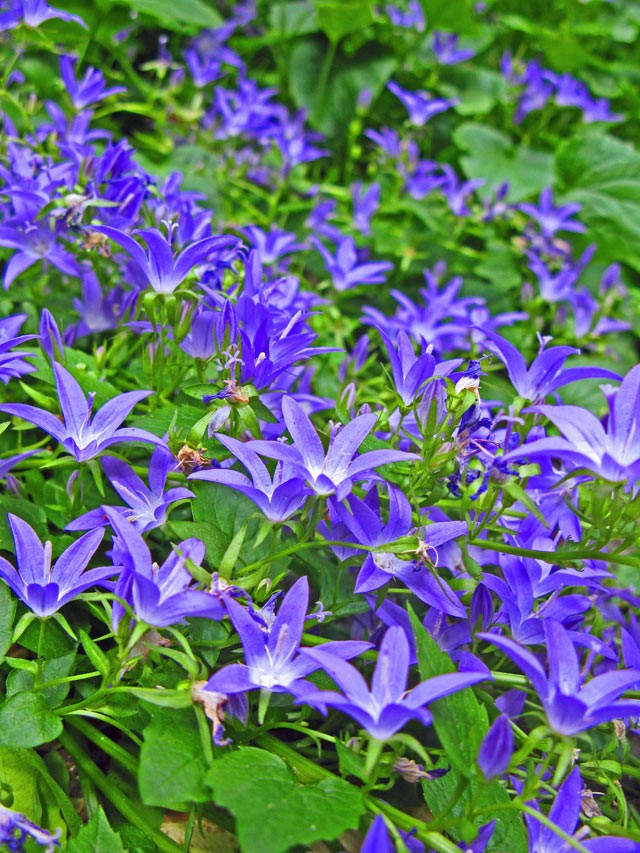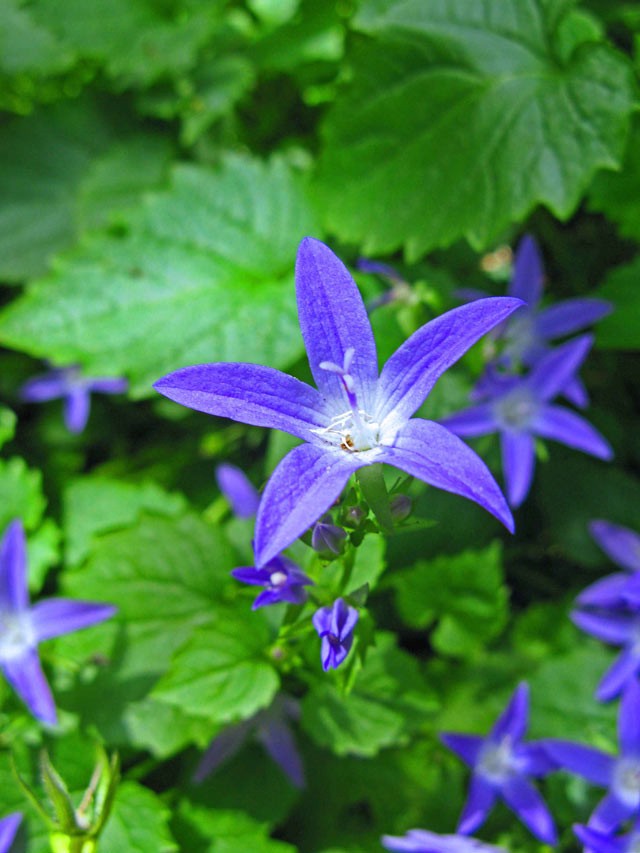Cascading Campanula

With spring almost a fading memory, the June garden offers more subdued and textured pleasures. The deciduous trees have leafed out, the tips of the conifers-which just a few weeks ago were shimmering and almost translucent-have matured, and the deep burgundy tones of the Japanese maple and columnar beech have been diluted with a more pedestrian if not completely unsatisfying green. Not that I’m complaining: there’s still much to look forward to during what remains of the growing season before the August doldrums, and if anything, later arrivals in the garden should be all the more valued as a result of our awareness of the limited time that remains.

No doubt other plant lovers have their favorites during this time of year; for me and Stephen, the Adriatic Bellflower (Campanula garganica) takes center stage. Our campanula is a low, spreading variety that occupies a promontory overlooking a sea of moss-covered brick. It gets nice early-morning sun and (thanks to us, if not always Mother Nature) ample water and organic, fishy-smelling fertilizer, which is all it needs to send forth a carpet of blossom-covered tendrils to cascade over the rocks.

I can’t use the word “cascade” without thinking of our friend T, a rather large, garrulous, and for that reason, perhaps imposing man who used to spend summers with his boyfriend in Tarrytown, where his flower boxes of cascading annuals attracted the attention of a local outfit, the Ladies Village Improvement Society, or something similar. One day some representatives knocked on his door and asked if “the lady of the house” was present because they wanted to invite her to join. “You’re looking at her,” he responded archly, which at the time (the late 80s) caused shockwaves to ripple through the Westchester gardening community. Recently I overheard some young queen refer to his love of “hanging” or “falling” plants and I felt compelled to pass along this important terminology: if you’re going to embrace a life in the garden, there’s little point in going halfway.

Last weekend a much younger friend joined us for dinner. In the early-June heat we admired the flowering blue stars and discussed our friend’s imminent travel plans, which include a long-anticipated vacation to ___ and ___, countries he has never before visited, but which Stephen (who has) assured him has gorgeous beaches and famous cruising grounds populated by legions of very attractive non-heterosexual men. “I am so getting fucked every single night of this trip,” our young guest did not so much confess as proclaim, and I appreciated his candor and enthusiasm, particularly when I compared it to the sad, overwrought inhibition I suffered at his age. My mother often likes to try to convince me (or more to the point, herself) that society is improving for non-heterosexuals, and as evidence of this she regularly points to the inclusion of gay kids at high-school proms around the country. “I guess that’s promising,” I usually say to her, and there’s a part of me that wants to believe; after all, there’s a new generation at hand, and I try to take the same comfort in their existence as I do the new flowers in the garden.

“Would you like to visit the Adriatic Sea, home of our lovely bellflower?” I asked Stephen after our young friend had left. “Maybe someday,” he offered after a few moments of consideration, but with a kind of wistfulness I understood. Traveling more than a day or two-what with the expense and airport ordeals and abandonment of our cats and dread of returning to the same problems we left behind-has lost some of the appeal it once held for us. These days, we’re more inclined to stay in the garden and watch the campanula bloom, creating the illusion of a night sky, allowing us to remain insulated from the larger and more maddening uncertainties of the larger world beyond.
Matthew Gallaway is a writer who lives in Washington Heights. Come, let us go together and learn all about his first novel, The Metropolis Case
.
